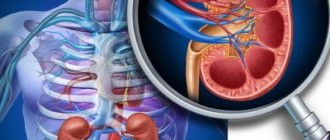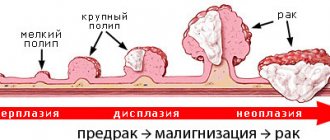Sepsis - main symptoms: Skin rash Headache Skin rash Poor circulation Chills Fever Increased sweating Loss of appetite Rapid breathing Rapid pulse
Sepsis is a blood infection that occurs as a result of the penetration of an infectious agent and its spread throughout the body. Contrary to the existing opinion that blood poisoning can develop only when severe wounds suppurate, sepsis in adults can occur due to other causes, some of which cannot be identified.
Sepsis is a severe infectious disease that develops as a systemic inflammatory reaction when infectious agents enter the blood
How to recognize sepsis in time, why can a pathological process occur in an adult, and is it possible to stop and prevent a dangerous condition?
Causes of sepsis development
If it is difficult to establish the primary inflammatory focus, and the bacteria have already entered the blood, then a diagnosis of “cryptogenic sepsis” is made.
The causes of this disease can be different. Typically, the etiology is no different from other types of sepsis. The difference is that inflammation in some organ develops too quickly or the patient’s immunity is significantly reduced. At the same time, the time from the onset of the disease to the spread of infection (breakthrough of the outbreak) is reduced.
In this case, the patient does not have time to understand which symptoms began to bother him in the first place. In most patients, the primary lesion can be detected after examination. If it is still not found, then the pathology is classified as cryptogenic sepsis. Causes of the disease:
- Bacterial infection. Sepsis can be caused by any microorganism. Most often these are staphylococci and streptococci, Proteus, Pseudomonas aeruginosa and Escherichia coli.
- Conditionally pathogenic microflora. As you know, there are many bacteria in the body that are present normally. With a decrease in immune defense, opportunistic microflora begins to grow, which leads to various diseases. As a result, cryptogenic sepsis may develop.
- Infections caused by pathogenic fungi (candidiasis).
- Primary and secondary immunodeficiencies (HIV).
- Period of prematurity, newborns with low body weight (up to 2 kg).
- Intrauterine infections.
Cryptogenic sepsis - what is it? A similar diagnosis is made in the absence of a primary pathology that can lead to blood poisoning. Cryptogenic sepsis is also called primary, or idiopathic.
It develops when pathogenic microorganisms enter the bloodstream. As a result, bacteria are spread throughout the body. As a result, inflammatory foci can be localized in several places at once.
In addition, bacterial intoxication of the body develops. In such cases, the immune system is not able to cope with a large number of pathogens. Often this condition leads to disruption of the cardiovascular system.
For the development of sepsis, it is necessary that pathogenic bacteria - infectious agents (bacteria, viruses, fungi) enter the body. As a result of mass infection with putrefactive destruction products of pathogenic microorganisms and toxins, an inflammatory process occurs.
The inflammatory reaction of the body that occurs in response to the introduction of infectious agents is associated not so much with the pathogens themselves, but with the state of the person’s immune forces. A decrease in protective forces leads to the fact that the body cannot localize pathogenic organisms in time and prevent their spread into various organs.
The following may contribute to the development of sepsis:
- Violation of the rules of antisepsis and asepsis when treating purulent wounds, as well as during surgical interventions.
- Incorrect selection of antibacterial agents in the treatment of internal inflammatory processes.
- Immune system disorders.
The highest likelihood of developing sepsis is in people with long-term chronic diseases, who have a weakened immune system against this background.
What diseases can be complicated by sepsis:
- Osteomyelitis;
- Burns, extensive injuries;
- Infectious and inflammatory diseases;
- Wounds and ulcers on the skin;
- Pneumonia, purulent formations in the lungs;
- Severe forms of tonsillitis;
- Infectious and inflammatory complications after surgery;
- Purulent otitis;
- Peritonitis;
- Carbuncle, boil;
- Congenital pathologies of the immune system;
- Infection after childbirth, miscarriages, abortions;
- HIV infections;
- Oncological diseases.
This list is quite arbitrary, because... sepsis can complicate any infectious and inflammatory process in the body.
For the development of sepsis, certain conditions must be met:
- The presence of a primary focus (source of infection), from which pathogenic organisms enter the blood.
- Distribution of pathogens through the bloodstream throughout the body.
- The formation of secondary foci, from which pathogens will also spread throughout the body in the future.
- The response of the defense system to the penetration of pathogens by an inflammatory process.
- The body’s inability to build the necessary immune defense and respond in a timely manner to the introduction of pathogens.
To successfully treat a patient, it is necessary first of all to determine the “gate” through which sepsis entered the body, and only then to activate the body’s defenses to neutralize harmful pathogens.
Etiology of sepsis
Sepsis is polyetiological. However, the main role belongs to opportunistic bacterial pyogenic flora (staphylococcus, streptococcus, pneumococcus, etc.). Discussions continue about the possibility of including viruses and fungi among the causative agents of sepsis.
Generalized viral infections are not usually considered as sepsis, although there are indications of this in modern studies. Severe malaria and other parasitic infestations, as well as infections caused by rickettsia, chlamydia, and mycoplasma are not taken into account as sepsis.
The question of the possibility of a mycotic etiology of sepsis is also debated. In some publications, mycotic sepsis (candidal septicemia - B37.7) usually refers to candemia and acute disseminated candidiasis, but the latter usually occurs in very severe immunodeficiency, such as, for example, in HIV-infected patients in the terminal stages, cancer patients and during organ transplantation in conditions of immunosuppression.
Sepsis caused by different groups of opportunistic pathogens has some differences, but still not so characteristic or specific, and therefore cannot be attributed to any specific nosological form. At the same time, there is no reason to use such outdated terms as “tuberculous sepsis”, “typhoid sepsis”, “anthrax sepsis”, “meningococcal sepsis”, etc.
In modern clinical classifications of infectious diseases, these terms are rightly not used. In these cases, we can talk about generalized forms of diseases of certain nosologies that have a clearly defined pathogen and require etiotropic treatment.
Sepsis is a primitive general reaction of the body to the invasion of an infection, since tissue lesions in it do not have specific signs (for example, specific granulomas, as in rheumatism, typhus, tuberculosis, etc.).
Sepsis is a severe generalized form of the disease. No one doubts this postulate. The main morphological criterion for the generalization of the infection is a metastatic focus far from the primary focus, that is, sepsis always occurs as septicopyemia and it is purulent metastasis in the internal organs that determines the “separation” of the general manifestations of the disease from the primary inflammatory focus.
It is known that blood cannot be a place for long-term residence of microorganisms, being for them only a temporary transport medium, and in order to survive, the pathogen must be fixed in tissues and organs, where it will find suitable conditions for its habitat and life.
Immediately after fixation of the microbe in organs and tissues, a local cellular inflammatory reaction occurs, which within 2-3 hours leads to the formation of a microabscess, that is, septicopyemia develops. It should be emphasized that the indisputable fact is that representatives of the strepto- and staphylococcal group of microorganisms, which are the causative agents of septicopyemia in 95-98% of cases, have the greatest ability to cause metastatic foci.
At the same time, representatives of gram-negative bacterial flora are more likely to develop local resorption-toxic processes and infectious-toxic shock. This emphasizes the importance of the etiological factor in the specific development of septic diseases.
What is this in simple words?
Sepsis is a general infection of the body in which the infection spreads through the bloodstream. With sepsis, it is not a single organ that is inflamed, but the entire body.
In 70% of patients, sepsis is a complication of local inflammation: abscess, phlegmon, boil, meningitis, pneumonia, pleurisy, lymphadenitis, etc., as well as a wound process: trauma, surgery, etc. It is important to emphasize that sepsis develops when the body’s defenses are depleted (immunity) as a result of a prolonged primary inflammatory process.
The causative agents of sepsis are various bacteria (staphylococci, streptococci, meningococci, pneumococci, enterococci, E. coli, salmonella, etc.) and fungi (Candida, Aspergillus, etc.).
Diagnosis and treatment of blood diseases
When making a diagnosis, a history and blood test results are key. When interviewed, patients complain of increased or decreased body temperature, increased respiratory rate and swelling. Sometimes it is possible to identify an altered state of consciousness. High levels of glucose, white blood cells and reactive protein are found in the blood. Blood pressure is low. Multiple abnormalities in the functioning of internal organs are revealed. Patients complain of a decrease in the volume of urine excreted and intestinal obstruction as a result of the lack of peristalsis.
To identify cryptogenic sepsis, tests such as extended leukocyte count, urinalysis, renal function testing, blood clotting testing, etc. may be performed.
Treatment measures are carried out quickly, since the spread of pathogens and death are possible. The procedures are carried out in intensive care conditions. For sepsis, treatment is aimed at maintaining a satisfactory condition and suppressing inflammation. Artificial ventilation may be performed. In case of dehydration, intravenous fluid infusions are given. A catheter is installed to remove urine. When glucose concentrations are high, insulin is administered. Antimicrobials are used to fight pathogens.
Classification of cryptogenic sepsis
Considering that the primary localization of the pathological focus is unknown, cryptogenic sepsis is not classified according to etiology. Nevertheless, it is necessary to establish the causative agent of infection in order to carry out adequate antibacterial therapy.
- Septicemia. This refers to the presence of bacterial or fungal microflora circulating throughout the body. However, pathogens do not form foci of infection.
- Septicopyemia. In addition to the presence of bacteria in the blood, organs are contaminated with them. Often, pathogens accumulate (settle) in the lungs, brain, and abdominal cavity. As a result, foci of purulent inflammation form in these areas.
According to the clinical course, fulminant, acute and chronic sepsis are distinguished. In the first case, the disease develops already in the first day after penetration of the pathogen and is characterized by severe dysfunction of organs and systems.
Acute sepsis lasts about 2-4 weeks. Chronic damage can last for months or even years. It is characterized by the development of exacerbations and remissions. In some cases, a subacute variant of sepsis is observed. Its duration ranges from 6 to 12 weeks.
Forms of sepsis are classified depending on the location of the primary infectious focus. Based on this symptom, primary (cryptogenic, essential, idiopathic) and secondary sepsis are distinguished.
- pleuropulmonary – develops against the background of purulent lung diseases (abscess pneumonia, pleural empyema, etc.)
- odontogenic – caused by diseases of the dental system (caries, root granulomas, apical periodontitis, periostitis, peri-maxillary phlegmon, osteomyelitis of the jaws)
- tonsillogenic - occurs against the background of severe sore throats caused by streptococci or staphylococci
- surgical – develops when infection enters the blood from a postoperative wound
- obstetric-gynecological – occurs after complicated abortions and childbirth
- Urosepsis – characterized by the presence of entrance gates in the sections of the genitourinary apparatus (pyelonephritis, cystitis, prostatitis)
- cutaneous – the source of infection is purulent skin diseases and damaged skin (boils, abscesses, burns, infected wounds, etc.)
- peritoneal (including biliary, intestinal) – with localization of primary foci in the abdominal cavity
- rhinogenic – develops due to the spread of infection from the nasal cavity and paranasal sinuses, usually with sinusitis
- otogenic - associated with inflammatory diseases of the ear, most often purulent otitis media.
- umbilical – occurs with omphalitis of newborns
We invite you to familiarize yourself with: Fundus examination - how the examination is carried out, results (normal and pathological), price.
Fundus examination in pregnant women, children, newborns. Where can I get tested? Based on the time of occurrence, sepsis is divided into early (occurs within 2 weeks from the appearance of the primary septic focus) and late (occurs later than two weeks). According to the rate of development, sepsis can be fulminant (with rapid development of septic shock and death within 1-2 days), acute (lasting 4 weeks), subacute (3-4 months), recurrent (lasting up to 6 months with alternating attenuation and exacerbations) and chronic (lasting more than a year).
Sepsis in its development goes through three phases: toxemia, septicemia and septicopyemia. The toxemia phase is characterized by the development of a systemic inflammatory response due to the onset of the spread of microbial exotoxins from the primary site of infection;
in this phase there is no bacteremia. Septicemia is marked by the dissemination of pathogens, the development of multiple secondary septic foci in the form of microthrombi in the microvasculature; persistent bacteremia is observed.
What is sepsis: description and types
Sepsis is a severe purulent-septic infectious process that is secondary, that is, it occurs when pathogenic flora enters the bloodstream from the primary source of infection.
Infectious agents may enter the blood during surgical interventions, venous catheterization and other medical procedures.
Infectious agents can enter the body in various ways - the primary source of inflammation can be wounds and microtraumas, and even a regular insect bite. But blood poisoning can also occur due to the unfavorable course of purulent processes inside the body (for example, peritonitis or abscess) against the background of weakened immunity.
Important! Two thirds of patients see a doctor for other diseases, and only then do they develop sepsis.
There are many types of sepsis, which are classified depending on the location of the source of infection, the type of pathogen and the place of its penetration, the nature of the course of the disease and the changes that occur in the body after infection.
Types of sepsis
| Classification | Kinds | Description |
| By type of pathogen |
| In order for sepsis to develop, one of the listed pathogens must enter the human body. |
| According to the speed of development | Fulminant sepsis | Rapid onset (develops within 1-2 days after exposure to infectious agents), severe course, poor prognosis. |
| Acute sepsis | Symptoms of the infectious process make themselves felt within a week. | |
| Subacute sepsis | Symptoms are vague and can increase and appear over several months. | |
| Chroniosepsis | Symptoms appear no earlier than six months after infection. More common in patients with immunodeficiencies. | |
| At the point of entry of the pathogen | Nosocomial sepsis | Appears as a result of various medical procedures:
|
| Community-acquired sepsis | Appears as a result of complications of any infectious disease:
| |
| According to the characteristics of clinical symptoms | Toximia | A systemic inflammatory process caused by the spread of infection from the primary focus. |
| Septicemia | The general condition of the body is disturbed, inflammatory reactions occur, but there are no purulent foci in the internal organs. The condition occurs quickly and is acute. | |
| Septicopyemia | Purulent foci form in the internal organs. |
There is also neonatal sepsis, which develops in newborns due to pathogenic microorganisms entering the baby's body in the womb.
The spread of sepsis causes damage and disruption of the functioning of almost all systems and organs, and therefore poses a danger to the patient’s life. Treatment of this condition requires immediate hospitalization of the patient in the intensive care unit or intensive care unit.
Symptoms of cryptogenic sepsis
The clinical course of sepsis can be fulminant (rapid development of manifestations within 1-2 days), acute (up to 5-7 days), subacute and chronic.
Atypical or “erased” symptoms are often observed (for example, at the height of the disease there may not be a high temperature), which is associated with a significant change in the pathogenic properties of pathogens as a result of the massive use of antibiotics.
Sepsis can occur with the formation of local abscesses in various organs and tissues (infection from the primary focus) - the so-called. septicopyemia, in which the course of sepsis depends on the location of the ulcers (for example, an abscess in the brain with corresponding neurological disorders), and without metastatic ulcers - the so-called. septicemia, often with a more rapid course, pronounced general symptoms.
When diagnosing, there are:
- Systemic inflammatory response syndrome. Characterized by changes in body temperature (both upward, more than 38 °C, and downward, below 36 °C), rapid heartbeat (more than 90 beats per minute) and breathing (more than 20 breaths per minute), changes in the number of leukocytes in blood (less than 4x109 or more than 12x109 cells per liter of blood).
- Sepsis. With the same symptoms as in the case of systemic inflammatory syndrome, one of the known pathogens is detected in one of the normally sterile tissues (in the blood, cerebrospinal fluid, urine...), signs of peritonitis, pneumonia, purpura and other local inflammatory processes are revealed.
- Severe sepsis. Characterized in the same way as regular sepsis, but with hypotension, hypoperfusion, or organ dysfunction.
- Septic shock. The most severe condition, after which death occurs in every second patient due to impaired blood supply to organs and tissues. It is defined by the same symptoms as sepsis, when intensive resuscitation measures do not lead to normalization of blood flow and blood pressure levels. Other signs of septic shock include slow urine production and confusion.
In February 2020, the concepts and diagnostic criteria for sepsis were revised. The concepts of systemic inflammatory response syndrome and severe sepsis were recognized as irrelevant, and new definitions were given to the concepts of sepsis and septic shock.
To identify and diagnose sepsis, it is recommended to use the SOFA and qSOFA scales.
Only by checking the blood for sterility can one judge whether a person has cryptogenic sepsis. The symptoms of this disease can resemble many other pathologies. This is due to the fact that with all inflammatory processes, intoxication of the body develops.
However, a doctor may suspect this disease based on the characteristic clinical picture. First of all, such a diagnosis is assumed only when other inflammatory pathologies are excluded. The following symptoms of sepsis are distinguished:
- Increased body temperature up to 39-40 degrees. Hyperthermia is accompanied by chills, sweating and headache.
- Deterioration of condition. With sepsis, weakness, pain in muscles and joints without a specific localization, and decreased appetite are observed.
- Tachycardia - increased heart rate.
- Reduced blood pressure.
- Increased breathing rate.
- Liver dysfunction. Manifested by the development of jaundice, an increase in the size of the organ (hepatomegaly).
- Damage to the gastrointestinal tract. Some patients experience stool upset (diarrhea), nausea and vomiting.
- The appearance of hemorrhages on the skin.
With the development of septicopyemia, other symptoms may be observed. They depend on the location of the inflammatory foci. Endocarditis and pneumonia often develop.
First signs and main symptoms
Clinical symptoms of sepsis depend on the type of pathogen that is the root cause of the development of the infectious process. Combined forms of pathology can often occur, in which infection occurs under the influence of the simultaneous reproduction of several pathogens.
Sepsis is characterized by erased symptoms, but the main signs of the pathological process remain the same characteristic signs:
- Body temperature rises to high levels (38-39 degrees) or, conversely, drops below 36 degrees.
- The heart rate accelerates (more than 90 beats per minute).
- Rapid breathing (more than 20 breaths per minute).
- Leukocytosis or leukopenia is detected in blood tests.
Sepsis can develop at lightning speed, so the first symptoms are detected within 1-2 days after infection.
With the rapid development of blood poisoning, severe sepsis develops, characterized by impaired consciousness (in severe cases, coma occurs), a drop in blood pressure, and the appearance of a specific rash on the mucous membranes and skin. , painful pallor of the patient.
Important! Sepsis is characterized by a large number of deaths. In most cases, this is due to the fact that people do not pay due attention to the first symptoms of the disease and turn to doctors too late.
Signs of sepsis largely depend on the spread of infection and damage to the body.
With septicemia, the pathological process develops rapidly and occurs in a severe form with rapid deterioration. Initially, the manifestations of the disease are similar to the symptoms of a respiratory infection, but the clinical picture increases rapidly and literally within a few hours the patient’s condition worsens:
- The temperature rises (up to 39-40 degrees) and at the same time the pulse quickens, severe sweating and chills occur;
- Small red dots appear on the skin (in the form of a rash), which gradually develop into hemorrhages throughout the body;
- The patient’s general condition worsens (headaches, irritability, loss of appetite, apathy, etc.);
- Blood circulation and breathing are impaired (increased heart rate, rapid breathing, decreased blood pressure).
With septicemia, obvious lesions cannot be detected in most cases, which significantly complicates diagnosis and worsens the prognosis for curing the disease.
Note! The most dangerous is staphylococcal sepsis, which is very difficult to cure due to high antibiotic resistance.
With septicopyemia, the source of infection can be determined immediately - usually it is a large external abscess, although purulent foci may also be present in the internal organs. This form of sepsis develops less rapidly (within a few weeks) and is severe, but is no less life-threatening and requires immediate treatment.
With septicemia, small red dots appear on the skin, which, with complications of the disease, develop into hemorrhages throughout the body
Blood sepsis can manifest itself in different ways, but the course of the disease is usually rapid, so treatment should be carried out as quickly as possible before the process causes irreversible consequences.
First signs
The complaints of patients are very diverse, but the main attention should be paid to the following symptoms of sepsis:
- severe chills;
- increased body temperature;
- change in the patient’s mental state (euphoria or, conversely, apathy);
- tired, indifferent look;
- pale skin;
- hollow cheeks;
- facial hyperemia;
- profuse sweating;
- petechial hemorrhages in the form of stripes and spots on the surface of the forearms and legs.
In addition, sepsis can manifest itself as herpes on the lips, bleeding of the mucous membranes of the oral cavity, difficulty breathing, the appearance of lumps and pustules on the skin.
Diagnostic criteria for cryptogenic sepsis
The diagnostic criteria for sepsis include the clinical manifestations of this disease, as well as changes observed during laboratory and instrumental research methods. First of all, pay attention to the general condition of the patient.
We suggest you read: Recurrent herpes: why the disease appears too often
If it worsens over several days, despite antibacterial therapy, cryptogenic sepsis can be suspected. Signs that indicate this disease are an earthy (grayish) color of the skin, severe general weakness, increased temperature and the appearance of skin hemorrhages.
Laboratory and instrumental diagnostics
Diagnosis of sepsis is carried out using laboratory and clinical methods:
- A general blood test allows us to identify the inflammatory picture as a whole;
- blood culture. For an accurate diagnosis, it is recommended to do multiple cultures, which makes it possible to take into account the life cycle of the pathogen at different stages of therapy. Blood is taken from the patient's vein and subjected to laboratory analysis;
- bacterial culture contained in the purulent focus;
- biochemical blood test (taken from a vein, the analysis is carried out on an empty stomach);
- the PCR method allows you to isolate the DNA of the pathogen;
- X-rays, ultrasound, computed tomography, and MRI are used to search for primary lesions.
All these techniques make it possible to diagnose blood poisoning, including cryptogenic sepsis, and determine how to treat it.
In cryptogenic sepsis, significant changes in laboratory parameters are observed. The CBC shows leukocytosis, thrombocytopenia and anemia, as well as accelerated ESR. Bacteria can be present not only in the blood, but also in the urine.
Changes are observed in biochemical parameters. These include the appearance of C-reactive protein, a possible increase in the level of bilirubin, ALT, AST (with liver damage). The main marker of sepsis is a blood test for sterility (blood culture for microflora). Thanks to this study, it is possible to identify the causative agent of the disease and prescribe treatment.
Instrumental diagnostics are carried out to detect foci of septic lesions. For this purpose, a chest x-ray, ultrasound of the abdominal and pelvic organs are performed. Inflammation in the lungs is often detected - pneumonia, enlargement of the liver - hepatomegaly.
Pathology can be diagnosed using bacteriological blood culture
Diagnosis of sepsis is a rather complex process. Neither laboratory nor instrumental methods can give an accurate answer. The doctor relies on the patient’s condition, examination and test data, compares them and, based on this, makes a decision on the choice of treatment methods.
Required research:
- Blood tests - biochemical, bacteriological.
- Bacteriological culture of discharge from a possible source of infection.
- Antibiotic sensitivity test.
- Urine tests.
- MRI for signs of multiple organ failure.
If necessary and if there is time, the doctor may prescribe other types of studies to determine the degree of dysfunction of certain organs. The criteria for diagnosing sepsis are the detection of bacteria in the blood (bacteremia) in combination with high fever and a tendency for the patient’s condition to worsen, as well as the presence of foci of infection in several internal organs at the same time. Two out of three signs are a sufficient criterion for making a diagnosis.
However, the concepts of bacteremia and sepsis should be distinguished. The presence of bacteria in the blood can be short-term and does not always affect the general condition of the patient, and also does not always lead to purulent screenings and the emergence of new lesions.
Diagnostics
To make an accurate diagnosis, the doctor first studies the symptoms of the pathology. A blood test must also be performed. Otogenic sepsis is characterized by neutrophilic leukocytosis and an increase in erythrocyte sedimentation rate. Also, young immature cells can be detected in the peripheral blood.
Blood culture data will help clarify the diagnosis. It is recommended to take it when the temperature increases. It is during this period that there is every chance of identifying pathogenic microorganisms. To assess the extent of destruction of the temporal bone, radiography is performed.
Diagnosis of otogenic sepsis of varying severity
Neonatal sepsis
With the development of sepsis in newborns (the source is a purulent process in the tissues and vessels of the umbilical cord - umbilical sepsis), vomiting, diarrhea, complete refusal of the child to breastfeed, rapid weight loss, and dehydration are characteristic;
Factors of sepsis in newborns include:
- Infectious and inflammatory diseases in a pregnant woman (pyelonephritis, adnexitis, colpitis);
- Signs of infection of the amnion (“dirty” water, deposits on the placenta);
- Out-of-hospital birth;
- Infections in the postpartum mother (endometritis, mastitis);
- Anhydrous period during childbirth {amp}gt; 6 hours.
Possible complications of sepsis
With the wrong approach to the treatment of sepsis, severe complications develop. Among them are shock, pulmonary embolism, bacterial endocarditis, stroke, exhaustion and bleeding.
Septic shock
The most severe complication of sepsis. The functioning of all organs, metabolism, and blood flow are disrupted. The risk of developing septic shock is highest in elderly people and patients with weakened immune systems. Up to half of all patients with this complication die.
Symptoms of septic shock:
- increased body temperature over 39°C;
- or a decrease in body temperature less than 36°C;
- increased heart rate more than 90 beats per minute;
- rapid breathing, shortness of breath;
- nausea, vomiting, diarrhea;
- decreased amount of urine;
- significant deterioration of the patient's condition;
- disturbance of consciousness: first the patient becomes excited, claims that everything is fine with him, and then lethargy and lethargy arise;
- thirst;
- drop in blood pressure;
- dry and pale skin;
- then cold, sticky sweat occurs;
- hemorrhages on the skin;
- cyanosis of fingertips, nose, lips, earlobes.
If a patient in a state of septic shock does not receive urgent medical care, he will die.
Thrombophlebitis
Thrombophlebitis is an inflammation of the venous wall with the formation of blood clots on it.
Symptoms:
- pain in the area of the affected veins;
- redness of the skin, painful lumps;
- swelling of the affected limb.
Most often it is a complication of thrombophlebitis. In thromboembolism, a piece of the blood clot breaks off, travels through the bloodstream into the heart, and then into the pulmonary vessels. Having reached a sufficiently small vessel, the thrombus blocks it.
Symptoms:
- dyspnea;
- the skin becomes pale and acquires an ash-gray tint;
- cyanosis of fingertips, nose, lips, earlobes;
- difficulty breathing, wheezing is heard;
- cough, during which blood may come out with sputum;
- pain in half of the chest;
- drop in blood pressure;
- increase in heart rate to 100 beats per minute;
- severe pain in the chest;
- heart rhythm disturbance;
- dizziness, tinnitus;
- loss of consciousness, fainting;
- coma;
- pain under the right rib;
- belching, nausea, vomiting.
The course of pulmonary embolism can vary. Sometimes it is not accompanied by virtually any symptoms, and sometimes it quickly leads to the death of the patient.
We suggest you read: Treatment of candidiasis in the mouth due to HIV
It is usually a complication of thrombophlebitis. Often happens at night.
Symptoms:
- disturbance of consciousness, state of stupefaction;
- increased drowsiness;
- disturbance of orientation in time and space;
- headaches, symptoms resembling meningitis;
- disturbances in movement and sensitivity, reflexes, depending on which vessel the blood clot is stuck in, and which part of the brain was deprived of oxygen as a result.
Statistics show that every fourth patient with sepsis loses about 20% of weight.
Bleeding
As a result of vascular damage during sepsis, internal bleeding can develop in various organs, for example, in the stomach. The patient's condition worsens, pallor and weakness appear.
Treatment of cryptogenic sepsis
Sepsis is treated only in an infectious diseases or therapeutic hospital, in the intensive care unit. The principles of treatment are similar to the treatment of other foci of infection, but the general serious condition and the risk of death are taken into account.
For the treatment of sepsis in adults, the following is used:
- antibiotics in maximum doses, taking into account sensitivity, intravenously.
- carry out an active fight against toxicosis,
- activate their own immune system, correct disrupted vital processes.
It is necessary to create rest and isolation, a special diet is prescribed, and in case of a severe condition - artificial intravenous nutrition.
It is important to remove the infection from the primary focus and use two or more antibiotics, sometimes in combination with hormones.
If necessary, patients receive an infusion of blood plasma, gamma globulin and glucose.
When secondary purulent foci form, their surgical treatment is necessary - opening abscesses, removing pus and washing the wounds, excision of the affected areas.
First of all, when this disease is detected, the patient should be hospitalized and placed on bed rest. These measures are also necessary if cryptogenic sepsis is suspected. Treatment begins immediately after diagnosis.
The main group of drugs is antibiotics. A combination of 2-3 medications is prescribed. The most commonly used drugs are Penicillin, Ceftriaxone, Gentamicin, Imipenem, etc. Since there is intoxication of the body, infusion therapy is prescribed.
Crystalloid and colloid solutions are administered intravenously, and blood transfusion is performed according to indications. Immunostimulants, antipyretics and analgesics are also indicated. If a source of infection is identified, surgical intervention is necessary.
Treatment for sepsis should be started immediately after diagnosis is made. The basis of therapy is antibiotics, since only they can eliminate the cause of the disease - infection. The selection of antibiotics is made in two ways - empirical and based on the results of an antibiogram.
The empirical way is the prescription of a drug without data on the sensitivity of the pathogen to it. The doctor chooses the drug based on assumptions about what microorganism caused sepsis and what antibiotic will be effective.
Typically, broad-spectrum products are used. If the patient’s condition does not improve within 3 days, the drug is changed to another. This approach is justified in the early stages of sepsis - the patient needs immediate help, and test results do not come back instantly.
Treatment is complex and carried out in a hospital setting
An antibioticogram is one of the mandatory laboratory tests for sepsis. The pathogen is isolated from the blood and discharge and its type is determined. Then a sensitivity test is carried out - the colony of bacteria is exposed to various antibiotics available in the hospital.
Based on the results, they determine which drug will be the most effective. Some microorganisms grow quite slowly, and the doctor receives the test results after the patient’s condition has been stabilized.
In addition, maintaining vital body functions is extremely important. Treatment of sepsis is carried out in intensive care, where the doctor is able to constantly monitor cardiac activity, breathing, liver and kidney function. If necessary, the patient undergoes artificial ventilation and hemodialysis.
To reduce intoxication, the patient is injected intravenously with solutions that improve blood flow - saline solution, reopolyglucin; if necessary, blood transfusion is possible. Diuretics are prescribed (forced diuresis), which helps remove toxins from the body.
The rapid development of pathology may not leave time for effective treatment and leads to a very high mortality rate. Acute and subacute sepsis are slightly less dangerous in this regard, but the mortality rate in both cases is close to 50%.
Sepsis is a dangerous disease that can cause death
Complications of sepsis are directly related to its pathogenesis. The most common among them are purulent screenings (metastases) and multiple organ failure.
The term “metastasis” is used not only in oncology. In the development of the infectious process, it means the emergence of new foci of infection. In the presence of bacteremia, the pathogen settles in various organs, and if local immunity cannot effectively fight them, foci of purulent inflammation arise.
Multiple organ failure occurs due to purulent foci and hemodynamic disorders. Most often, liver and kidney failure develop simultaneously; the addition of respiratory or cardiac failure almost always leads to death. Failure of other organs does not have time to have a significant impact on the patient’s condition.
A course of antibiotic therapy, if prescribed, should be carried out correctly - this will eliminate the pathogen before it becomes the cause of sepsis. After operations, a course of antibacterial drugs is specifically prescribed to prevent blood poisoning.
How to treat sepsis
If sepsis is suspected or detected, you should immediately seek medical help.
Treatment of sepsis is carried out necessarily with hospitalization of the patient in the intensive care ward or intensive care unit (depending on the complexity of the case). This is necessary to monitor vital indicators: the amount of urine excreted, oxygen saturation of venous blood, venous and blood pressure.
During the first 6-12 hours after hospitalization, doctors will focus their efforts on stabilizing these indicators through infusion therapy. Activities are carried out intravenously using various protein and saline solutions, blood substitutes, etc.
Important! Mortality with the development of sepsis reaches 50%, but if resuscitation measures are performed correctly, this figure decreases by 2-3 times.
After sepsis has been diagnosed, subsequent treatment consists of sanitizing the source of infection that led to the infection, eliminating complications that have arisen, and increasing the patient’s defenses.
With sepsis, death is possible in 50% of cases, so at the first symptoms you should immediately consult a doctor
First of all, the pathogens that led to the infection should be destroyed. To do this, the patient is prescribed antibiotics, having previously analyzed the sensitivity of a particular antibacterial agent to a specific pathogen.
To enhance the effect, 2-3 antibacterial drugs can be prescribed simultaneously, the treatment of which is carried out for a fairly long time - 6-10 weeks.
The group of antibiotics is selected depending on the type of pathogen. It can be:
- Cephalosporins;
- Carbalenemes;
- Penicillins;
- Levomycetin antibiotics;
- Lincosamides;
- Aminoglycosides, etc.
A patient with sepsis should definitely boost their immunity, since if the blood is infected, the body is not able to cope with the infection on its own.
To increase the body's defenses, immunostimulants are used: Thymogen, Vilozen, Timoptin, Timalin, Myelopid, etc.
Other drugs are prescribed based on the patient’s condition and the disorders caused in the body by sepsis. Vitamins and mineral complexes, painkillers, drugs that restore the functions of damaged internal organs, medications to normalize blood pressure, etc. may be prescribed.
Drug therapy will not be successful without destroying the source of infection that caused blood sepsis.
Therefore, surgical sanitation of the source of infection is mandatory, which is aimed at opening the abscess and cleansing it of the exudate contents, removing all dead tissue that poisons the body with decay products, and treating it with antiseptic materials.
To combat sepsis, complex treatment is used, which may include surgical debridement of the lesion, massive antibacterial or antifungal therapy, and detoxification therapy.
In the presence of a secondary source of infection, similar surgical sanitation is performed.
Prevention
Sepsis often develops in people suffering from chronic inflammatory diseases. Therefore, preventive measures include timely treatment of foci of infection, taking immunostimulating drugs and vitamins.
Prevention of sepsis is based on correct and timely treatment of local purulent processes and compliance with aseptic conditions during operations and other medical procedures.
The prevention of sepsis can also include the competent use of antibacterial agents. It should be understood that any bacteria and fungi can develop resistance to drugs. The stronger antibiotics we use, the stronger and “smarter” our opponents become.
The use of the latest generations of antibiotics without appropriate indications deprives us of the means to fight in truly serious situations when these drugs could save people's lives. Any antibiotics should be used strictly as prescribed by your doctor.











